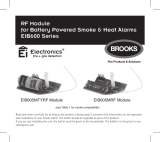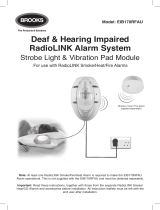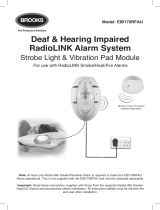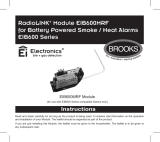Page is loading ...

Instruction Manual
Read and retain carefully for as long as the product is being used. It contains vital information on the operation and installation of your
Fire / CO Alarm Interface. The booklet should be regarded as part of the product.
If you are just installing the unit, the booklet must be given to the householder. The booklet is to be given to any subsequent user.
Model: Ei414
Fire / CO Alarm Interface

Contents
1. Introduction & Connection Diagrams ........................................................................................
2. Typical Installation Examples ..........................................................................................................
3. Installation ............................................................................................................................................
4. House Coding .......................................................................................................................................
5. Testing ....................................................................................................................................................
6. Service Relay ........................................................................................................................................
7. User Information ................................................................................................................................
8. Troubleshooting the RadioLINK .....................................................................................................
9. Technical Specification .....................................................................................................................
10. Service & Guarantee .........................................................................................................................
11. Contact Us ............................................................................................................................................
3
8
11
18
22
23
24
26
27
28
32
Page
2

1. Introduction
The Ei414 Fire / CO Alarm Interface can be used to connect Ei Electronics RadioLINK Alarm Systems to
suitable other Systems such as Fire Panels, Telecare Systems, Auto Diallers, Security Systems etc. The Ei414
has 3 output relays for Fire, CO & Service that can be triggered by an Ei Electronics RF Alarm System. These relays
can be directly connected to the other Systems or alternatively can be used to trigger one of the other Systems
RF transmitters. A RadioLINK system consists of Ei Electronics RadioLINK Smoke, Heat and CO Alarms along with
RadioLINK accessory devices that are interconnected using the Ei Electronics proprietary RF protocol system. The
Ei414 must be House Coded to the other RadioLINK devices in the system.
service
ON TEST
OFF
Fire / CO Alarm Interface
Alarm Code LED’s
RadioLink LEDPower LED
Key Switch
On
Off
Test
open screws
then insert screwdriver into the notch to remove cover
How to remove Cover
Fire / CO Alarm Interface
3

Wireless Smoke Alarm System Wireless Smoke &
Carbon Monoxide Alarm System
RF Smoke Alarm
Alarm Controller
Model No. - AlarmsComment
Ei262 Mains Carbon Monoxide Alarms The Ei262 has built-in RadioLINK technology
Ei140RC, Ei160e & Ei2110e Series Alarms
Due to our continuous improvements policy, product performance and features are being frequently updated - See Contact Us section
The Ei140RC Series Alarms must be fitted on Ei168RC RadioLINK bases.
The Ei160e & Ei2110e Series Alarms must be fitted with an Ei100MRF RadioLINK
+
Module.
Ei605 & Ei650 Series Smoke Alarms Alarms must be fitted with the correct Ei605 & Ei650 series RadioLINK module
Ei208W powered for life Carbon Monoxide Alarms The Alarms must be fitted with Ei200MRF RadioLINK modules
Ei170RF & other RadioLINK devices Contact us or visit our website for details
Works
with
RF CO Alarm
Alarm Interface Alarm Interface
RF Smoke Alarm
Alarm Controller
RF Smoke Alarm
RF Smoke Alarm
RF Smoke Alarm
4

5
External Panel
(Fire / Telecare etc.)
Ei414
service
ON TEST
OFF
Fire / CO Alarm Interface
Hardwired Output Connection Diagram
230VAC
11 - 30VDC
Ei208WRF
For connection to External Panel see Manufacturers instructions
Ei650RF Ei168RCEi262 Ei450
RF Signal Input
from Ei Alarm System
Fire / CO Alarm Controller
Ei414
service
ON TEST
OFF
Fire / CO Alarm Interface
230VAC
11 - 30VDC
Ei208WRF
For connection to External Panel & RF Transmitter see Manufacturers instructions
For connection to External Devices see Manufacturers instructions
Ei650RF Ei168RCEi262 Ei450
RF Signal Input
from Ei Alarm System
Fire / CO Alarm Controller
Ei208WRF Ei650RF Ei168RCEi262 Ei450
RF Fire Signal
Output
Fire / CO Alarm Controller
External RF Panel
(Fire / Telecare etc.)
Wireless (RF) Connection Output Diagram
External Device
(Strobe etc.)
Ei414
service
ON TEST
OFF
Fire / CO Alarm Interface
External
Fire Panel
External
Device
(sprinkler flow valve)
Input Connection Diagram
230VAC
RF
Transmitter
RF
Transmitter
RF
Transmitter

6
External Panel
(Fire / Telecare etc.)
Ei414
service
ON TEST
OFF
Fire / CO Alarm Interface
Hardwired Output Connection Diagram
230VAC
11 - 30VDC
Ei208WRF
For connection to External Panel see Manufacturers instructions
Ei650RF Ei168RCEi262 Ei450
RF Signal Input
from Ei Alarm System
Fire / CO Alarm Controller
Ei414
service
ON TEST
OFF
Fire / CO Alarm Interface
230VAC
11 - 30VDC
Ei208WRF
For connection to External Panel & RF Transmitter see Manufacturers instructions
For connection to External Devices see Manufacturers instructions
Ei650RF Ei168RCEi262 Ei450
RF Signal Input
from Ei Alarm System
Fire / CO Alarm Controller
Ei208WRF Ei650RF Ei168RCEi262 Ei450
RF Fire Signal
Output
Fire / CO Alarm Controller
External RF Panel
(Fire / Telecare etc.)
Wireless (RF) Connection Output Diagram
External Device
(Strobe etc.)
Ei414
service
ON TEST
OFF
Fire / CO Alarm Interface
External
Fire Panel
External
Device
(sprinkler flow valve)
Input Connection Diagram
230VAC
RF
Transmitter
RF
Transmitter
RF
Transmitter

7
External Panel
(Fire / Telecare etc.)
Ei414
service
ON TEST
OFF
Fire / CO Alarm Interface
Hardwired Output Connection Diagram
230VAC
11 - 30VDC
Ei208WRF
For connection to External Panel see Manufacturers instructions
Ei650RF Ei168RCEi262 Ei450
RF Signal Input
from Ei Alarm System
Fire / CO Alarm Controller
Ei414
service
ON TEST
OFF
Fire / CO Alarm Interface
230VAC
11 - 30VDC
Ei208WRF
For connection to External Panel & RF Transmitter see Manufacturers instructions
For connection to External Devices see Manufacturers instructions
Ei650RF Ei168RCEi262 Ei450
RF Signal Input
from Ei Alarm System
Fire / CO Alarm Controller
Ei208WRF Ei650RF Ei168RCEi262 Ei450
RF Fire Signal
Output
Fire / CO Alarm Controller
External RF Panel
(Fire / Telecare etc.)
Wireless (RF) Connection Output Diagram
External Device
(Strobe etc.)
Ei414
service
ON TEST
OFF
Fire / CO Alarm Interface
External
Fire Panel
External
Device
(sprinkler flow valve)
Input Connection Diagram
230VAC
RF
Transmitter
RF
Transmitter
RF
Transmitter

8
2. Typical Installation Examples
Ei650RF
Smoke Alarm
Ei603TYCRF
Heat Alarm
RF Transmitter
RadioLINK Battery Powered Alarm System
Ei164e
Heat Alarm
Ei146RC
Smoke Alarm
with Ei168RC
RadioLINK Base
Ei208WRF
Carbon Monoxide
Alarm
RadioLINK / Hard Wired Hybrid System
Ei164e Heat Alarm
fitted with Ei100MRF
RadioLINK
+
Module
Ei414
Ei146RC Smoke Alarm
with Ei168RC
RadioLINK Base
RadioLINK Mains Powered Alarm System
Fire / CO Alarm Controller
Ei650RF
Smoke Alarm
Ei450 Alarm
Controller
Fire / CO Alarm Controller
Ei450 Alarm
Controller
Fire / CO Alarm Controller
Ei450 Alarm
Controller
service
ON TEST
OFF
Fire / CO Alarm Interface
RF Transmitters
Ei414
fire
CO
service
ON TEST
OFF
Fire / CO Alarm Interface
External Panel
(Fire / Telecare etc.)
Ei414
service
ON TEST
OFF
Fire / CO Alarm Interface
External RF Panel
(Fire / Telecare etc.)
External RF Panel
(Fire / Telecare etc.)
In the event of a fire, the Ei140RC / Ei160e /
Ei2110e will detect Smoke / Heat and either the
Ei100MRF or the Ei168RC base will transmit an
RF fire signal to the Ei414. The Ei414 will then
trigger the external panel.
N.B. The Ei450 Alarm Controller MUST be
used to test the RadioLINK Alarm System (at
least 1 x Ei168RC must be fitted - see ‘User
Information’ section).

9
Ei650RF
Smoke Alarm
Ei603TYCRF
Heat Alarm
RF Transmitter
RadioLINK Battery Powered Alarm System
Ei164e
Heat Alarm
Ei146RC
Smoke Alarm
with Ei168RC
RadioLINK Base
Ei208WRF
Carbon Monoxide
Alarm
RadioLINK / Hard Wired Hybrid System
Ei164e Heat Alarm
fitted with Ei100MRF
RadioLINK
+
Module
Ei414
Ei146RC Smoke Alarm
with Ei168RC
RadioLINK Base
RadioLINK Mains Powered Alarm System
Fire / CO Alarm Controller
Ei650RF
Smoke Alarm
Ei450 Alarm
Controller
Fire / CO Alarm Controller
Ei450 Alarm
Controller
Fire / CO Alarm Controller
Ei450 Alarm
Controller
service
ON TEST
OFF
Fire / CO Alarm Interface
RF Transmitters
Ei414
fire
CO
service
ON TEST
OFF
Fire / CO Alarm Interface
External Panel
(Fire / Telecare etc.)
Ei414
service
ON TEST
OFF
Fire / CO Alarm Interface
External RF Panel
(Fire / Telecare etc.)
External RF Panel
(Fire / Telecare etc.)
In the event of a fire, the Ei650RF / Ei603TYCRF
will detect Smoke / Heat and transmit an
RF fire signal to the Ei414. The Ei414 will
then trigger the RF transmitter and alert the
external panel.

10
Ei650RF
Smoke Alarm
Ei603TYCRF
Heat Alarm
RF Transmitter
RadioLINK Battery Powered Alarm System
Ei164e
Heat Alarm
Ei146RC
Smoke Alarm
with Ei168RC
RadioLINK Base
Ei208WRF
Carbon Monoxide
Alarm
RadioLINK / Hard Wired Hybrid System
Ei164e Heat Alarm
fitted with Ei100MRF
RadioLINK
+
Module
Ei414
Ei146RC Smoke Alarm
with Ei168RC
RadioLINK Base
RadioLINK Mains Powered Alarm System
Fire / CO Alarm Controller
Ei650RF
Smoke Alarm
Ei450 Alarm
Controller
Fire / CO Alarm Controller
Ei450 Alarm
Controller
Fire / CO Alarm Controller
Ei450 Alarm
Controller
service
ON TEST
OFF
Fire / CO Alarm Interface
RF Transmitters
Ei414
fire
CO
service
ON TEST
OFF
Fire / CO Alarm Interface
External Panel
(Fire / Telecare etc.)
Ei414
service
ON TEST
OFF
Fire / CO Alarm Interface
External RF Panel
(Fire / Telecare etc.)
External RF Panel
(Fire / Telecare etc.)
In the event of a fire /
CO event, the relevant
Smoke / Heat / CO
Alarm will transmit an
RF signal to the Ei414.
The Ei414 will then
trigger the relevant RF
transmitter and alert the
external panel.

0I
CNONCCNO NC CNONC
ON
1
2
1
2
0I
ON
+
SW SW
LNE
+
Fire Relay
Screw Fixings
Dip Switch (default)
Antenna
Battery Backup Switch
RadioLINK LED
Power LED
Service Relay
CO Relay
Screw Fixings
Screw Fixings
Battery Backup Switch
Screw Fixings
Voltage Input 12 - 24V
AC Mains Input 230V
Volt Free Contacts
DC Power In 11 - 30V
Trigger inputs to send fire
signal to the RF Alarm
system. These inputs will
also activate fire relay
(see Dip Switch operation)
Power inputs
Note: This MUST be switched to the
‘ON’ position upon installation (see ‘Installation’ section)
(N.B. The Lithium battery is not replaceable)
11
3. Installation

0I
CNONCCNO NC CNONC
ON
1
2
1
2
0I
ON
+
SW SW
LNE
+
Fire Relay
Screw Fixings
Dip Switch (default)
Antenna
Battery Backup Switch
RadioLINK LED
Power LED
Service Relay
CO Relay
Screw Fixings
Screw Fixings
Battery Backup Switch
Screw Fixings
Voltage Input 12 - 24V
AC Mains Input 230V
Volt Free Contacts
DC Power In 11 - 30V
Trigger inputs to send fire
signal to the RF Alarm
system. These inputs will
also activate fire relay
(see Dip Switch operation)
Power inputs
Note: This MUST be switched to the
‘ON’ position upon installation (see ‘Installation’ section)
(N.B. The Lithium battery is not replaceable)
12

AC Mains Wiring (230V)
Warning: To prevent injury, this apparatus must be securely attached to
the wall in accordance with the installation instructions.
1. Remove the cover (see page 3). Mount the Ei414 in a suitable location
on a wall using the fixings provided, away from any objects that may
block the RF signal (i.e away from metal surfaces). The Ei414 may also be
mounted on a 35mm Din Rail. Mounting clips for this application must
be purchased seperately.
2. Disconnect the AC mains supply from the circuit that is going to be
used. The disconnect device (i.e mains switch) must be an all pole circuit
breaker, with a contact gap of minimum 3mm and disconnects both
poles simultaneously.
3. The house wiring must be connected to the terminal block on the unit:
L: Live – connect to the house wires coloured brown or marked L
N: Neutral – connect to the house wires coloured blue or marked N
E: Earth – connect to yellow/green wires or marked E
Note: Wiring must be installed in compliance with local regulations and
by qualified/competent personnel.
13
Mounting and Wiring
+
SW SW
LNE
+
Front View: standard wiring
from wall mount

14
(See adjacent diagram for wiring option using surface trunking and
knockout segments on the back of the base. Remove segments using
a pliers or similar).
4. The green LED will indicate if power has been connected.
5. Ensure the Dip Switch has been set to the correct orientation (see
‘Dip Switch Operation section’).
6. Important: The backup battery switch must be switched on.
7. If using an RF Transmitter connect as advised by the manufacturer to
the relevant relay. Use the knockout segments on the back of the base.
Remove segments using a pliers or similar (See diagrams on page 15).
8. Fit and secure the top cover with the screws provided. (see page 3).
9. Insert and turn the key supplied to the ‘TEST’ position to begin
system testing (see ‘TESTING’ section).
For a 11-30V DC external source
1. The Ei414 should be located next to DC external source.
2. Locate the auxiliary power output in the DC external source and wire
it to the DC Power Input connector on the Ei414.
3. Check that the polarity of the auxiliary power supply has been wired
correctly and the power LED is on.
Surface
Trunking
Knockout
segments
Rear View: optional wiring
using surface trunking

4. The trigger input voltage signal is optional
and can be triggered by either a 12-24V DC
power supply or alternatively from a dry
contact signal.
5. Repeat steps 5 to 9 as above.
Caution - Alternative Energy Sources –
(wind, solar, UPS etc.)
This product is designed to be connected
to a True Sine Wave 230VAC supply. If
connecting to a power source that uitilises
an inverter, e.g. PV solar panel, the Total
Harmonic Distortion (THD) must be
less than 5%. If in doubt please check
with the manufacturer of the inverter.
This also applies to battery powered UPS
(Uninterruptible Power Supply) inverters
or Light Dimmer Circuits. The Ei414 must
not be connected when the house wiring
insulation is being checked with high voltages, i.e. do not use a high voltage insulation tester on the
unit. The unit must not be exposed to dripping or splashing.
15
CNONCCNO NC CNONC
RF
Transmitter
Knockout
segments
Front View:
RF Transmitter installation
Rear View:
Knockout segments

16
DIP Switch Operation
The Ei414 contains a dip switch which specifies whether the device will work in continuous mode or
through a pulsed operation. It is also used to determine whether a hard-wired trigger input will activate
the fire relay or not.
Please note: The dip switch only applies to the Fire and CO relays, it does not apply to the Service relay.
ON
ON ON ON
= Switch
1
1
2
1
2
1
2
1
2
2
1
2
1
2
1
2
ON ON ON ON
= Switch
1
1
2
1
2
1
2
1
2
2
1
2
1
2
1
2
ON
ON
ON ON
= Switch
1
1
2
1
2
1
2
1
2
2
1
2
1
2
1
2
Relay activates immediately. A hard-wired trigger input will not activate the fire relay
Switch 1 & 2 in the ‘1 & 2’ position
Relay activates immediately. A hard-wired trigger input will activate the fire relay
Switch 1 & 2 in the ‘ON’ position
ON ON
ON
ON
= Switch
1
1
2
1
2
1
2
1
2
2
1
2
1
2
1
2
Relay activates and resets approx 4 seconds later (pulse). A hard-wired trigger input
will not activate the fire relay.
Switch 1 in the ‘O’ position & switch 2 in the ‘2’ position
ON ON ON
ON
= Switch
1
1
2
1
2
1
2
1
2
2
1
2
1
2
1
2
Relay activates and resets approx 4 seconds later (pulse). A hard-wired trigger input
will activate the fire relay in the same pulsed operation.
Switch 1 in the ‘1’ position & switch 2 in the ‘N’ position

17
ON TEST
OFF
ON TEST
OFF
ON TEST
OFF
The Ei414 will be shipped
in the ‘OFF’ position.
When in the ‘OFF’
position the Ei414 does
not respond to any RF
signals.
In the ‘ON’ position the
Ei414 responds to a fire
alarm signal (activates
the fire relay) or to a CO
alarm signal (activates
the CO relay).\
It will not respond to a
button test signal.
In the ‘TEST’ position the
Ei414 responds to a button
test signal (will activate
the fire or the CO relay
depending on the unit that
was button tested).
N.B. When testing the
system with an Ei450
Alarm Controller, only the
fire relay will activate.
Keyswitch Orientations

4. House Coding
It is essential to House Code the Ei414 to all the other RadioLINK
Alarms and devices in the system to ensure they will not communicate
with nearby systems. Failure to House Code the system may also result
in a system malfunction.
To House Code:
Using a small screwdriver press and hold the House Code
button on the bottom of the Ei414 then release. The
RadioLINK blue LED will light up and then flash rapidly
for a moment.
House Code all other RadioLINK Alarms and devices in the system.
Consult the instruction manuals on how to House Code the Alarms and
devices. It is essential that each individual Alarm / device is put into
House Code mode in it’s actual location.
WARNING
House Code Switch
RadioLINK LED
Fire / CO Alarm Interface
18

19
Return to the Ei414 and check that RadioLINK LED is
flashing blue. The number of flashes should equal the
number of RadioLINK Alarms and devices in the system. A
system with 2 x Smoke Alarms, 1 x CO Alarm, 1 x Alarm
Controller and 1 x Ei414 will result in 5 blue flashes. It
may take up to 10 minutes before all 5 flashes are seen.
The flash pattern will repeat every 5 to 10 seconds while
the Ei414 remains in House Code.
If it fails to flash the correct number of times, then
consult the ‘Troubleshooting’ section of this instruction
manual.
Now, walk around the house to verify that all the other
RadioLINK Alarms and devices are giving the correct
amount of flashes.
If any of these fail to flash the correct number of
times, then consult the ‘Troubleshooting’ section of this
instruction manual.
House Code Switch
RadioLINK LED
Fire / CO Alarm Interface

20
To complete the commissioning, the system must exit House Code mode.
The units will automatically exit House Code after 30 minutes. Once coded
the system will not communicate with any other RadioLINK Alarms and
devices outside the House Coded group.
To manually exit House Code press the House Code button
on the Ei414. When the RadioLINK LED lights up blue,
release the button. This unit will then send an exit House
Code signal to all the other RadioLINK Alarms and devices
to exit House Code.
After a short period the blue light will turn off and the
system will return to standby mode (normal). Depending on
the number of RadioLINK Alarms and devices in the system
this period could vary from 5 to 20 seconds.
House Code Switch
RadioLINK LED
Fire / CO Alarm Interface
/




